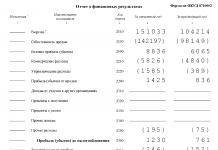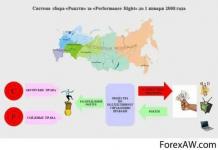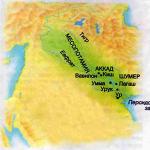2 Drawing up a schedule of expected cash receipts from sales
It is very important to plan the cash flow coming from customers for sold products. The procedure for settlements between the seller and buyers is fixed in a bilateral agreement between them.
Foreign practice shows that many American companies establish a three-month period for cash settlements with suppliers (sellers) of products or services. In this case, collection coefficients are empirically established (receipts of funds to the current account of an organization (enterprise). The main purpose of drawing up a schedule for the receipt of funds from sales is to obtain information about future receipts of funds and balances of receivables at the end of each month of the year.
Table 6 - Initial data for solving task No. 2 “Drawing up a schedule of expected cash receipts from sales”
|
In thousand rubles |
|
Indicators |
Option 18 |
|
1 Balance of accounts receivable at the end of the year (actual) |
|
|
2 Amount of debt to be repaid in the planning period |
|
|
3 Collection ratio;, %: |
|
|
Current period |
|
|
Next |
|
|
Subsequent |
1 Table 7 includes from the source data (Table 6) the balance of receivables at the end of the pre-plan year and the expected amounts to be received from the balance of receivables of the pre-plan year in January and February of the plan year.
2 Based on the given collection ratios, which are obtained based on an analysis of cash receipts for the enterprise for the previous year, cash receipts for the months of collection are calculated. For example, 30% of sales are paid in the current month in which the products were sold, 55% in the next and 10% in the subsequent month, the remaining 5% represent bad debts.
The ratio of bad debts to collection is determined as a percentage as the difference:
where is the percentage of collection in the i-th plan month.
From Table 5 (the final line “Total Sales”) we take the amount of sales volume for January V JAN and using the collection ratios we find the amount of funds received for three months: in January - (V JAN 0.3), in February ( V JAN 0.55) and in March - ( V JAN 0.10), the remaining 5% (100 – 30-55-10) of V JAN constitute bad debts ( V JAN 0.05).
Sales receipts for January:
38588.2 x 0.3 = 11576.5 thousand rubles,
38588.2 x 0.55 = 21223.5 thousand rubles,
38588.2 x 010 = 3858.82 thousand rubles.
Sales receipts for February:
38371.6 x 0.3 = 11511.5 thousand rubles,
38371.6 x 0.55 = 21104.4 thousand rubles,
38371.6 x 0.1 = 3837016 thousand rubles.
Sales receipts March:
36720.5 x 0.3 = 11016.1 thousand rubles,
36720.5 x 0.55 = 20196.3 thousand rubles,
36720.5 x 0.1 = 3672.05 thousand rubles.
Table 7 has a checkerboard shape, since the months are indicated both horizontally (on the left) and vertically (on top), this allows you to distribute the monthly sales amounts from Table 5, located along the horizontal line of the corresponding month. After distributing funds by month using collection coefficients, the amounts of monthly receipts of funds are calculated in vertical columns, which are entered in the line “Total receipts” (at the bottom of Table 7). At the same time, in January and February the amounts of debt repayment of the previous year in the planning period are taken into account.
January: 4500 + 11576.5 = 16076.5 thousand rubles.
February: 700 + 21223.5 +11511.5 = 33435 thousand rubles.
March: 3858.82 +21104.4+11016.1=35979.3 thousand rubles.
Then the totals are calculated by row (month) and recorded in the last column (plan for the year).
January: 11576.5+21223.5+3858.82=36658.82 thousand rubles.
February: 11511.5+21104.4+3837.16= 36453.03 thousand rubles.
March: 11016.1+20196.3+3672.05= 34884.43 thousand rubles.
It is imperative to check whether the balance is maintained between the amount of funds in columns and the amount of funds in rows for the planning year (this does not include balances of receivables).
3. Carrying balances of receivables are calculated by month of the plan year (line at the top of table 7). Accounts receivable balances for January and February are determined by the formulas:
 (5)
(5)
Where D fact is the balance of accounts receivable at the end of the pre-planned year, thousand rubles;
January V - sales volume in value terms for January of the planning year, thousand rubles. (from table 5);
S Jan - the amount of funds received for the month of January (Table 7).
D Jan = 6300 + 38588.2 - 16076.5 = 28811.8 thousand rubles;
The resulting value D Jan is substituted into the formula for calculating accounts receivable for February (D Feb), etc.
D February = 28811.8 +38371.6 -33435 = 33748.4 thousand rubles;
D March = 33748.4 +36720.5 -35979.3 = 34489.5 thousand rubles.
Now let's conclude:
The balance of accounts receivable in the planning period increased by 130.3% compared to the actual period. This growth was due to an increase in sales volumes.
Schedule of expected cash receipts from sales
|
Name |
Months of the plan year |
|||||||||||||
|
Receivables balance at the end of the period, thousand rubles. |
||||||||||||||
|
Amount of debt to be repaid in the current period, thousand rubles. |
||||||||||||||
|
Revenue from sales each month, thousand rubles |
||||||||||||||
|
September |
||||||||||||||
|
Total receipts thousand rubles. |
||||||||||||||
The statement of cash flows of an enterprise enables users of financial statements to assess the ability of an enterprise to generate cash and cash equivalents, as well as to assess the enterprise's needs for the use of those cash flows. The purpose of IFRS 7 is to standardize cash flow information by classifying cash flows by type of activity: operating, investing and financing.
From July 1, you can purchase an online course on treasury . Course program >>
An entity shall prepare a statement of cash flows in accordance with the requirements of this Standard and present it as an integral part of its financial statements for each period for which financial statements are presented.
Enterprises generate and use cash regardless of the nature of the activity and regardless of whether cash can be considered as a product of the enterprise (for example, banks and other financial institutions). Enterprises need cash for the same reasons, no matter how different their activities are. All enterprises need cash to conduct operations, to pay off liabilities, and to pay dividends. Accordingly, IFRS 7 requires the presentation of a statement of cash flows from all entities.
We recommend seminar "Treasury: cash flow management" >>>
Benefits of a Cash Flow Statement
The statement of cash flows, when used in conjunction with other financial statements, allows users to evaluate changes in an entity's net assets, its financial structure (including liquidity and solvency), and its ability to influence the amount and timing of cash flows. The statement of cash flows is useful in assessing a business's ability to generate cash, and also in modeling, estimating, and comparing the present value of future cash flows with other businesses. The report allows you to compare data on the operating performance of different enterprises, since it eliminates the consequences of applying different accounting methods to similar transactions and events.
Historical cash flow data is often used to estimate the amount, timing and likelihood of future cash flows. They are also useful in examining the accuracy of previous estimates of future cash flows and in examining the relationship between profitability and net cash flows and the impact of price changes.
IFRS 7 Definitions
Cash include cash in accounts and on hand and demand deposits.
Cash equivalents - These are short-term, highly liquid investments that are easily convertible into known amounts of cash and are subject to an insignificant risk of changes in their value.
Cash flows - receipts and payments of cash and cash equivalents.
Operating activities - the main income-generating activities of the enterprise and other activities other than investment and financial activities.
Investment activities - acquisition and disposal of long-term assets and other investments that are not cash equivalents.
Financial activities - activities that lead to changes in the amount and composition of the contributed capital and borrowed funds of the enterprise.
Cash and cash equivalents
Cash equivalents are intended to cover short-term cash obligations and not for investments or other purposes. For an investment to qualify as a cash equivalent, it must be readily convertible to a known amount of cash and be subject to an insignificant risk of changes in value. Thus, investments are generally classified as cash equivalents only when they have a short maturity, such as 3 months or less from the date of acquisition. Investments in the equity of other entities are not included in cash equivalents unless they are, in substance, cash equivalents (for example, preferred shares purchased shortly before their maturity date and having a specified maturity date).
Bank loans are generally considered to be a financing activity. However, in some countries, bank overdrafts, repayable on demand, form an integral part of a company's cash management. In this case, bank overdrafts are included in the composition of cash and cash equivalents. A characteristic feature of such agreements with banks is that the bank account balance changes from positive to negative.
Cash flow does not include turnover between cash and cash equivalents items because these components are part of an enterprise's cash management and not part of its operating, investing, or financing activities. Cash management involves investing excess cash in acquiring cash equivalents.
Presentation of the Cash Flow Statement
The cash flow statement must contain information about cash flows for the reporting period, broken down into flows from operating, investing or financing activities.
An entity presents cash flows from operating, investing or financing activities in a form that best fits the nature of its activities. Classification by activity provides information that allows users to assess the impact of those activities on the financial position of an enterprise and the amount of its cash and equivalents. This information can also be used to assess the relationships between these activities.
The same transaction may involve cash flows classified differently. For example, loan payments may include both interest and principal. The interest portion may be classified as an operating activity and the principal portion as a financing activity.
Operating activities
The amount of cash flows from operating activities is a key indicator of how enterprises generate sufficient cash flows to maintain the enterprise's operating capabilities, repay loans, pay dividends and make other investments without resorting to external sources of financing. Information about specific components of cash flows from operating activities for prior periods, in combination with other information, will be useful in forecasting future cash flows from operating activities.
Cash flows from operating activities are primarily related to the core activities of the entity. These flows typically result from transactions included in the definition of profit or loss. Examples of cash flows from operating activities:
Cash receipts from the sale of goods and provision of services;
Cash receipts in the form of royalties, fees, commissions and other revenue;
Cash payments to suppliers for goods and services;
Cash payments to and on behalf of employees;
Cash receipts and payments to an insurance company for premiums, claims, annuities and other insurance benefits;
Cash payments or income tax refunds if they cannot be directly related to financing or investing activities;
Cash receipts and payments from contracts entered into for commercial or trading purposes.
Some transactions, such as the sale of equipment, may result in a gain or loss. Cash flows from such transactions are classified as cash flows from investing activities. However, cash payments made to produce or acquire assets for rental to others and their subsequent sale in accordance with paragraph 68A of IAS 16 Property, Plant and Equipment are classified as cash flows from operating activities. Cash receipts from leases and subsequent sales of such assets are also cash flows from operating activities.
An entity may hold securities and loans held for business or trading purposes, in which case they may amount to inventory acquired specifically for resale. Therefore, cash flows arising from the purchase or sale of these securities are classified as operating activities. Similarly, advances and loans provided by financial institutions are generally classified as operating activities because they relate to the principal activities of the institution.
Investment activities
Separate disclosure of cash flows from investing activities is important because it shows what expenses have been incurred to acquire resources intended to generate future earnings and future cash flows. Examples of cash flows from investing activities:
Cash payments for the acquisition of fixed assets, intangible and other long-term assets. These include payments related to capitalized development costs and independently produced fixed assets;
Cash proceeds from the sale of fixed assets, intangible assets and other long-term assets;
Cash payments for the acquisition of equity or debt instruments of other enterprises and interests in joint ventures (other than payments for instruments considered to be cash equivalents or held for business or trading purposes);
Cash proceeds from the sale of equity or debt instruments of other enterprises and interests in joint ventures;
Advances and loans provided to other persons (except for advances and loans provided by financial institutions);
Cash receipts from the return of advances and loans provided to other persons;
Cash payments or receipts under futures or forward contracts, options and swap agreements, unless the contracts are entered into for trading or trading purposes or the payments or receipts are classified as financing activities;
When a contract is accounted for as a hedge, the cash flows from the contract are classified in the same way as the cash flows from the hedged position.
Financial activities
Separate disclosure of cash flows from financing activities is important because this information is useful in forecasting the entity's future cash flows from those who finance it. Examples of cash flows from financing activities:
Cash proceeds from the issue of shares or other equity instruments;
Cash payments to owners for the acquisition or redemption of company shares;
Cash receipts from the issue of debentures, loans, bills, bonds, mortgages and other short-term and long-term borrowings;
Cash payments on borrowed funds;
Cash payments made by a tenant to reduce the outstanding balance of a finance lease.
Reflection of cash flows from operating activities
An entity must report cash flows from operating activities using either:
Direct method, which discloses information about the main types of gross cash receipts and payments;
An indirect method in which profit or loss is adjusted by taking into account the results of non-cash transactions, any deferred or accrued past or future cash receipts or payments arising from operating activities, and items of income or expense related to cash receipts or disbursements. investment or financial activities.
An entity is encouraged to use the direct method of presenting cash flows from operating activities. The direct method provides information useful for estimating future cash flows that is not available with the indirect method. When using the direct method, information on the main types of gross cash and payments can be obtained:
From enterprise accounts; or
By adjusting sales, cost of sales (interest and other similar income and expenses for financial institutions) and other items in the statement of comprehensive income, taking into account the following factors:
o Changes in inventories and accounts receivable and payable from operating activities during the period;
o Other non-monetary items; And
o Other items that give rise to cash flows from operating or financing activities.
When using the indirect method, net cash flow from operating activities is determined by adjusting profit or loss for the following factors:
Changes in inventories and accounts receivable and payable from operating activities during the period;
Non-cash items such as depreciation, amortization, valuation reserves, deferred taxes, unrealized foreign exchange gains or losses, retained earnings of associates and minority interest; And
Other items that give rise to cash flows from investing or financing activities.
Alternatively, net cash flow from operating activities may be presented indirectly by reflecting revenues and expenses disclosed in the statement of comprehensive income and changes in inventories and accounts receivable and payable from operating activities during the period.
Reflection of cash flows from investing and financing activities
An entity must report its principal gross cash receipts and gross cash payments arising from investing and financing activities separately, except for cash flows, which are reported on a net basis.
Reflection of cash flows on a net basis
Cash flows from the following operating, investing or financing activities may be reported on a net basis:
Cash receipts and payments on behalf of clients when the cash flow reflects the activities of the client rather than the activities of the enterprise; And
Cash receipts and payments for items characterized by rapid turnover, large amounts, and short maturities.
Acceptance and payment of bank demand deposits;
Investment company client funds; And
Rent collected on behalf of property owners and passed on to them.
Examples of cash receipts and payments on behalf of clients:
Examples of cash receipts and payments of fast turnover:
By the amount of debt of credit card holders;
Purchases and sales of investments; And
Other short-term loans, for example, with a repayment period of up to 3 months.
Cash flows arising from each of the following activities of a financial institution may be reported on a net basis:
Cash receipts and disbursements for accepting and disbursing fixed maturity deposits;
Placement and withdrawal of deposits in other financial institutions; And
Advances and loans to customers and repayment of these advances and loans.
Cash flow in foreign currency
Cash flows arising from foreign currency transactions must be reported in the entity's functional currency by applying to the foreign currency amount the exchange rate between the functional and foreign currencies at the date of the cash flows.
Cash flows of a foreign subsidiary must be translated at the appropriate exchange rate between the functional currency and the foreign currency at the date of the cash flows.
Cash flows denominated in foreign currencies are reported in accordance with IAS 21 The Effects of Changes in Foreign Exchange Rates. This allows you to use an exchange rate that is approximately equal to the actual rate.
Unrealized gains and losses resulting from changes in foreign exchange rates are not cash flows. However, the effect of changes in currency exchange rates on cash and cash equivalents available or expected to be received in foreign currencies is presented in the statement of cash flows to reconcile cash and cash equivalents at the beginning and end of the reporting period. This amount is presented separately from cash flows from operating, investing and financing activities and includes any differences that would have arisen had the cash flows been reported at period-end exchange rates.
Interest and dividends
Cash receipts and payments related to the receipt and payment of interest and dividends must be disclosed separately. Each such receipt or payment must be qualified on a consistent basis from period to period as a cash flow from operating, investing or financing activities.
The total amount of interest paid during the period is disclosed in the statement of cash flows, whether it is recognized as an expense in the income statement or capitalized in accordance with the permitted alternative treatment in IAS 23 Costs on loans."
For financial institutions, interest paid and interest and dividends received are classified as cash flows from operating activities. However, for other enterprises there is no consensus on how to qualify these payments and receipts. They may be classified as cash flows from operating activities because they are included in the definition of profit or loss. And at the same time, they can be classified as cash flows from financial and investment activities, since they represent financing costs or investment income.
Dividends paid may be classified as cash flows from financing activities because they are a financing cost. However, they may be classified as an element of cash flows from operating activities to help users assess the entity's ability to pay dividends from cash flows from operating activities.
Income tax
Payments of income taxes are disclosed separately and classified as cash flows from operating activities unless they can be directly attributed to financing or investing activities.
While tax expenses may be readily attributable to investing or financing activities, it is not practical to attribute the corresponding tax cash flows, and such cash flows may relate to a period different from the cash flow in the underlying transaction. . Therefore, taxes paid are generally classified as cash flows from operating activities. When it is practicable to attribute tax cash flows to a specific transaction classified as an investing or financing activity, those flows are classified accordingly.
When tax cash flows relate to more than one activity, the total amount of taxes is disclosed.
Investments in subsidiaries, associates and joint ventures
When accounting for investments in subsidiaries and associates accounted for using the equity or cost method, the statement of cash flows limits the investor to information about the cash flows between it and the investee, such as information about dividends and advances.
An entity that reports its interest in a jointly controlled entity (see IAS 31 Interests in Joint Ventures) using the proportionate consolidation method includes in its consolidated statement of cash flows its proportionate share of the cash flows jointly controlled enterprise. And an entity that reports its share using the equity method includes in the statement of cash flows information about the cash flows associated with investments in the jointly controlled entity, distributions of profits, and other payments or receipts between it and the jointly controlled entity.
Changes in direct ownership interests in subsidiaries and other business units
Aggregate cash flows arising from acquisitions and losses of control of subsidiaries and other business units must be presented separately and classified as investing activities.
An entity must disclose the following aggregate information relating to both acquisitions and losses of control over subsidiaries during the period:
Total compensation paid or received;
The share of compensation represented by cash or cash equivalents;
The amount of cash and cash equivalents held by subsidiaries or other business units over which control is gained or lost; And
The amounts of assets and liabilities, other than cash and cash equivalents, in subsidiaries or other business units over which control is gained or lost, summarized by major category.
Presenting in one line the cash flow impact of acquisitions or losses of control of subsidiaries or other business units, and separately disclosing the amounts of assets and liabilities acquired or disposed of, helps separate such flows from other flows arising from other operating, investing or financial activities.
The aggregate amount of cash paid or received as consideration upon gaining or losing control of a subsidiary or business unit is reported in the statement of cash flows less any cash and cash equivalents acquired or disposed of in such transactions or events.
Cash flows arising from changes in direct ownership interests in a subsidiary that do not result in a loss of control must qualify as cash flows from financing activities.
Changes in direct ownership interests in a subsidiary that do not result in a loss of control (for example, a parent's purchase or sale of equity interests in a subsidiary) are accounted for as equity transactions.
Non-monetary transactions
Investment and financing transactions that do not require the use of cash and cash equivalents should be excluded from the statement of cash flows. Such transactions must be disclosed in other forms of financial statements in a manner that provides all necessary information about such financing or investing activities.
A significant part of investment and financing activities does not have a direct impact on current cash flows, but at the same time affects the structure of capital and assets of the enterprise.
Components of cash and cash equivalents
An entity must disclose the components of cash and cash equivalents and provide a reconciliation of the amounts contained in the statement of cash flows with similar items presented in the statement of financial position.
Given the diversity of cash management practices and banking arrangements around the world, and in order to comply with IAS 1 Presentation of Financial Statements, an entity is required to disclose the policies it has adopted for determining the structure of cash and cash equivalents.
The effect of any change in the policy for determining the components of cash and cash equivalents, for example a change in the classification of financial instruments previously considered to be part of an entity's investment portfolio, is reported in accordance with IAS 8 Accounting Policies, Changes in Accounting Estimates and Errors.
Other disclosures
An entity must disclose, together with management's commentary, the amount of significant cash and cash equivalents held by the entity that is not available for use by the group.
There are various circumstances in which cash and cash equivalent balances may not be available for use by the group. For example, a foreign exchange control measure or other legal restrictions that prevent the use of these funds in the general manner by a parent or subsidiary.
Additional information may be relevant to users' understanding of the financial position and liquidity of the entity. Disclosure of this information, along with management comments, is encouraged and may include:
Amounts of unused loan funds that can be used to finance future operating activities and to repay investment obligations, indicating restrictions on the use of these funds;
Aggregated amounts of cash flows by operating, investing and financing activities related to interests in joint ventures, data on which are presented using the proportionate consolidation method;
Aggregate amounts of cash flows representing increases in operating capability, separate from the cash flows required to maintain operating capability; And
The amount of cash flows arising from the operating, investing and financing activities of each reportable segment (see IFRS 8 Operating Segments).
Separate disclosure of cash flows representing increases in operating capabilities and cash flows required to maintain operating capabilities allows users to determine whether the entity is providing sufficient funds to maintain its operating capabilities. An enterprise that does not allocate sufficient funds to maintain its operating capabilities may be sacrificing its future profitability in the name of maintaining current liquidity and distributing profits to owners.
Disclosure of cash flows by segment allows users to better understand the relationship between cash flows at the enterprise level as a whole and at the level of its individual components, as well as monitor the availability and variability of cash flows by segment.
Read the interview with the teacher of the treasury management seminar, director of the Alfa Business School A.A. Uvarova. in the magazine "I am number one" >>>
|
Name / period (quarter) |
Total |
||||
|
1. Balance of accounts receivable at the beginning of the period | |||||
|
2. Receipts from sales of each quarter | |||||
|
105 000 |
150 000 |
||||
|
168 000 |
240 000 |
||||
|
105 000 |
150 000 |
||||
|
168 000 |
168 000 |
||||
|
3. Total receipts | |||||
|
4. Accounts receivable at the end of the period |
Solution:
As initial data we use the result obtained in Table 1, clause 3.3. Total sales. We divide the sales totals (clause 3.3.) of each quarter in the proportion of 70% for the current quarter, 30% for the next quarter:
1st quarter:
150,000 * 70% = 105,000 rub.;
Total receipts for the first quarter are 105,000 rubles;
2nd quarter:
240,000 * 70% = 168,000 rub.;
Total receipts for the second quarter: 168,000 + 45,000 = 213,000 rubles.
III quarter:
150,000 * 70% = 105,000 rub.;
150,000 * 30% = 45,000 rub. (Accounts receivable at the end of the period);
Total receipts for the third quarter: 105,000 + 72,000 = 177,000 rubles;
IV quarter
240,000 * 70% = 168,000 rub.;
240,000 * 30% = 72,000 rub. (Accounts receivable at the end of the period);
Total receipts for the fourth quarter: 168,000 + 45,000 = 213,000 rubles.
Total receipts for the year:
105,000 + 213,000 + 177,000 + 213,000 = 708,000 rub.
Accounts receivable at the end of the year:
780,000 – 708,000 = 72,000 rub.
It is assumed that the optimal stock of finished goods for an enterprise is 20% of sales volume for the next quarter. The finished goods inventory at the beginning of the period is equal to the ending inventory of the previous period. The stock at the end of the fourth quarter is determined as follows: tables - 20 pcs., cabinets - 30 pcs. (Table 3).
Table 3
Production budget in natural units
|
Name / period (quarter) |
Total |
||||
|
1. Planned sales volume, units. |
|||||
|
1.1. | |||||
|
1.2. | |||||
|
Cabinets |
|||||
|
2. Planned balances of finished products at the end of the period, units. | |||||
|
2.1. | |||||
|
Tables |
|||||
|
2.2. | |||||
|
Cabinets | |||||
|
3. Balances of finished products at the beginning of the period, units. |
|||||
|
3.1. | |||||
|
Tables | |||||
Solution:
3.2.
Cabinets
4. Volume of finished products, units.
4.1.
Tables (clause 1.1 + clause 2.1 - clause 3.1)
4.2.
Cabinets (clause 1.2 + clause 2.2 - clause 3.2)
Clause 1.1 and clause 1.2 of Table 3 are filled in with data from Table 1.
clause 2. Planned balances of finished products at the end of the period
1st quarter
II quarter
clause 2.1. Tables = 100 * 20% = 20 units.
clause 2.2. Cabinets = 200 * 20% = 40 units.
4. Volume of finished products, units.
III quarter
clause 2.1. Tables = 200 * 20% = 40 units.
4.1.
clause 2.2. Cabinets = 300 * 20% = 60 units.
Cabinets (clause 1.2 + clause 2.2 - clause 3.2)
clause 3. The stock of finished goods at the beginning of the period is equal to the ending stock of the previous period. Accordingly, we transfer the data from clause 2.1. and clause 2.2. for the next quarter, clause 3.1. and clause 3.2.
clause 4. We calculate the volume of finished products as the sum of the planned volume and the planned balance at the end of the period minus the balance of finished products at the beginning of the period, i.e.:
IV quarter
clause 4.1. = clause 1.1 + clause 2.1 – clause 3.1;
clause 4.2. = clause 1.2 + clause 2.2 – clause 3.2;
clause 4.1. = 100 + 40 = 140 units.
clause 4.2. = 200 + 60 = 260 units.
clause 4.2. = 300 + 40 – 60 = 280 units.
clause 4.1. = 100 + 40 – 20 = 120 units.
clause 4.2. = 200 + 60 – 40 = 220 units.
Table 7 contains from the source data (Table 6) the balance of receivables at the end of the pre-plan year and the expected amounts to be received from the balance of receivables of the pre-plan year in January and February of the plan year.
From table 5 (the final line “Total sales”) we take the amount of sales volume for January V January and using the collection ratios we find the amount of funds received for three months: in January - (V JAN 0.35), in February (V JAN 0.45 ) and in March - (V JAN 0.15), the remaining 5% (100 - 35-45-15).
Sales receipts for January:
30744.46 x 0.35 = 10760.56 thousand rubles,
30744.46 x 0.45 = 13835.01 thousand rubles,
30744.46 x 0.15= 4611.66 thousand rubles.
Sales receipts for February:
30356.32 x 0.35 = 10624.71 thousand rubles,
30356.32 x 0.45 = 13660.34 thousand rubles,
30356.32 x 0.15 = 4553.44 thousand rubles.
Sales receipts March:
31009.92 x 0.35= 10853.47 thousand rubles,
31009.92 x 0.45 = 13954.46 thousand rubles,
31009.92 x 0.15 = 4553.44 thousand rubles.
Table 7 has a checkerboard shape, since the months are indicated both horizontally (on the left) and vertically (on top), this allows you to distribute the monthly sales amounts from Table 5, located along the horizontal line of the corresponding month. After distributing funds by month using collection coefficients, the amounts of monthly receipts of funds are calculated in vertical columns, which are entered in the line “Total receipts” (at the bottom of Table 7). At the same time, in January and February the amounts of debt repayment of the previous year in the planning period are taken into account.
January: 4300 + 10760.56= 15060.56 thousand rubles.
February: 900 + 13835.01+ 10624.71= 25359.72 thousand rubles.
March: 4611.66 + 13660.34+ 10853.47= 29125.49 thousand rubles.
Then the totals are calculated by row (month) and recorded in the last column (plan for the year).
January: 10760.56+ 13835.01+4611.66 = 29207.24 thousand rubles.
February: 10624.71+13660.34+4553.44 =28838.5 thousand rubles.
March: 10853.47+ 13954.46+ 4651.48= 29459.42 thousand rubles.
It is imperative to check whether the balance is maintained between the amount of funds in columns and the amount of funds in rows for the planning year (this does not include balances of receivables).
D Jan = D fact + V Jan - S Jan
D Feb = D Jan + V Feb - S Feb,
where D fact is the balance of accounts receivable at the end, thousand rubles;
January V - sales volume in value terms for January, thousand rubles;
S Jan - the amount of funds received for January, thousand rubles.
D Jan = 7100 + 30744.46 -15060.56 = 22783.9 thousand rubles;
The resulting value D Jan is substituted into the formula for calculating accounts receivable for February (D Feb), etc.
D February = 22783.9+ 30356.32- 25359.72 = 27780.5 thousand rubles;
D March =27780.5+31009.92-29125.49=29664.94 thousand rubles. Table 7 - Schedule of expected cash receipts from sales
|
Indicators |
||||||||||||||
|
Remaining dz at the end. |
||||||||||||||
|
period (thousand rubles) |
||||||||||||||
|
Amount owed |
||||||||||||||
|
and repay. In current |
||||||||||||||
|
Received from supply. |
||||||||||||||
|
(months thousand rubles) |
||||||||||||||
|
(thousand roubles.) |
||||||||||||||
|
Total admissions |
The balance of accounts receivable in the planning period increased by 95.1% compared to the actual period. This growth was due to an increase in sales volumes.
Alexey Alferov Deputy General Director for Economics and Finance of Nord-Service LLC
At all times, the issue of timely financing of organizations has been relevant, and in the rapidly changing conditions of the global economy, this issue has become a pressing issue. Accurate forecasting of cash flows from sales is necessary to ensure the fulfillment of contractual obligations to employees, shareholders, the government, suppliers and contractors. In addition, traditional forecasting, based on the formula DP = DZn + VR-DZk, fails, because does not take into account seasonal fluctuations, trends, and specifics of customer payments.
- Assess existing revenue forecasts and plans;
- In case of an unsatisfied assessment, model several forecasting methods;
- Evaluate forecasting models and select the technique that produces the least errors.
Let us show an example of calculations at a hypothetical enterprise “N” (construction). The examples use monthly interval estimation for simplicity. In practice, it may be necessary to analyze weekly or daily receipts.
1. Assessing sales department revenue plans
We will estimate the forecast (percentage of error) based on the approved revenue plans of the sales department (calculated based on the traditional method) and actual revenues from January to March 2012 (see Table 1) using the formulas:
RE = SE / Avg. arithm. * 100%, where
SE = √MSE
MSE = ∑(y t – ŷ) 2 / n, where:
RE - error percentage (ratio error);
SE - standard error;
MSE - mean square error;
y t – actual value;
y – predicted value of the time series;
n – number of periods;
Wed arithm. f. – arithmetic average of the actual series of receipts
Table 1 (million rubles)
According to Table 1 we get:
Wed. arithm. f. = 118.3
MSE = 130.0
SE = 11.4
RE = 9.6%
The percentage error (RE) exceeds 5%. This means that a more accurate method of forecasting cash flows must be sought.
2. Forecast methods
There are a large number of forecasting methods; their choice will depend on the specifics of the type of activity of the enterprise, seasonality, the degree of exposure of sales and payments to external conditions. We highlight the following methods:
2.1. Expert method
The method is based on subjective assessments of experts, is suitable for conditions of complete uncertainty, and is used in a written survey of sales department employees. Experts (agents) classify receipts by supervised clients and probabilities (realistic, optimistic, pessimistic). Classification by probability is based on an assessment of the “quality” of receivables with its analysis by maturity. An example of the calculation is given in Table 2 and Table 3.
Table 2
| Clients | Agents | Forecast for January (million rubles) | Forecast for February (million rubles) | Forecast for March (million rubles) | ||||||
|---|---|---|---|---|---|---|---|---|---|---|
| real | optimistic | pessimistic | R | O | P | R | O | P | ||
| 100% | 80% | 5% | 100% | 80% | 5% | 100% | 80% | 5% | ||
| A | Ivanov | 60% | 0 | 7% | 10% | |||||
| B | Petrov | 30 | 120 | 40 | 20 | 0 | 50 | |||
| IN | Ivanov | 10 | 10 | 40 | 25 | 20 | ||||
| Rest | 20 | 15 | 12 | 5 | 15 | 12 | 50 | 30 | 10 | |
| Total | 60 | 75 | 132 | 55 | 75 | 12 | 82 | 60 | 60 | |
Table 3
2.2. Average method
This is the simplest method based on the arithmetic mean formula
Q prog. = (sum(x1:xn))/n, where
amount(x1:xn) - the amount of payments from period 1 to period n
n - number of periods
In this case, the forecast can be made:
- Long-term average method (the sum of values with a previous time series of 12 months or more is divided by the number of periods);
- Using the moving average method (with a previous period of 3 to 9 months with the middle of the month corresponding to the forecast). For example, if in January, February, March 2005 the revenue values were 100, 90, 150, respectively, then according to this method the forecast for February 2006 will be equal to (100+90+150) / 3 = 113;
- Using the average method of a given period over several years (for example, add March 2010, March 2011 and March 2012, divide by 3);
- The two previous methods, but taking into account the seasonality factor;
- 3rd method taking into account the correction of the annual trend coefficient.
2.3. Weighted average method;
The method is based on calculating the average forecast by “weighting” previous periods. In this case, the greatest weights are given to the periods closest to the forecast and similar periods of previous years (taking into account seasonality).
For example, having income statistics for 2011, you can create the following table.
Table 4 (million rubles)
| Indicator name | Jan.11 | Feb.11 | Mar.11 | Oct.11 | Nov.11 | Dec.11 | Total |
|---|---|---|---|---|---|---|---|
| Weight January | 4 | 1 | 2 | 3 | 10 | ||
| Weight February | 4 | 1 | 2 | 3 | 10 | ||
| Weight March | 4 | 1 | 2 | 3 | 10 | ||
| Arrivals January | 119 | 98 | 118 | 122 | 457 | ||
| Arrivals February | 126 | 98 | 118 | 122 | 464 | ||
| Arrivals March | 108 | 98 | 118 | 122 | 446 | ||
| Weighted values January | 476 | 0 | 0 | 98 | 236 | 366 | 1176 |
| Weighted values February | 0 | 504 | 0 | 98 | 236 | 366 | 1204 |
| Weighted values March | 0 | 0 | 432 | 98 | 236 | 366 | 1132 |
Similar periods of the previous year were assigned the highest weight (4), which is due to the seasonality of the business; then, according to the degree of proximity to the billing month, the weights are reduced from 3 to 1 (from December to November).
The admission forecasts will be as follows:
2.4. Exponential smoothing method
The method is similar to the previous one, but differs in that the alpha factor (α) is selected as the weighting coefficient, which is multiplied by the previous actual value and its predicted value according to the formula:
B t = α y t-1 + (1- α) * B t-1
Where B t is the forecast of receipts for the next period t
B t-1 – forecast of receipts of the previous period
y t-1 - actual value of receipt of the previous period
α - alpha factor, or constant smoothing factor (0 ≤ α ≤ 1)
Example:
The forecast of receipts for December 2011 is equal to $1000, in fact the receipts are equal to $950. Let's take the value of the alpha factor - 0.15
y t-1 = 950; B t-1 = 1000; α= 0.15
B t = 0.15 * 950 + (1- 0.15) * 1000 = 142.5 + 850 = 993 pcs.
So, the forecast value of receipts for January 2012 is 993 units.
2.5. Multiple regression
The purpose of studying multiple regression is to represent revenue volume (Y) as the dependent variable and attempt to express revenue volume as a function of a number of independent variables
X1, X2,…, Xn, i.e. Y= a + b X1 + c X2 + …+ z Xn
For example, in company “N” an equation has been identified that can be used to determine the revenue forecast for January 2012 (Y):
Y = -1.3 +0.856 P + 0.126 H, where
P – accounts receivable for December 2011;
H – volume of services performed, but not confirmed by acts in November 2011 (type of activity – construction);
Thus, with a volume of services performed in November of 133 million and accounts receivable of 125 million in December 2011, the revenue forecast for January 2012 according to this formula will be 122.5 million rubles. , which is 2% error.
3. Evaluation and selection of techniques
Having calculated the error percentage (see Table 5), we come to the conclusion that the most reliable forecasting methods can be considered the weighted average method (3%) and the multiple regression method (4.2%). These techniques can be implemented into an automated cash flow budget system.


















